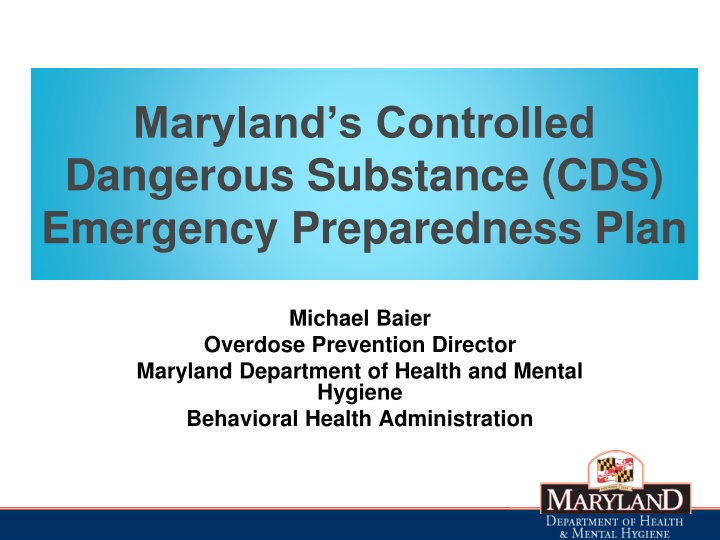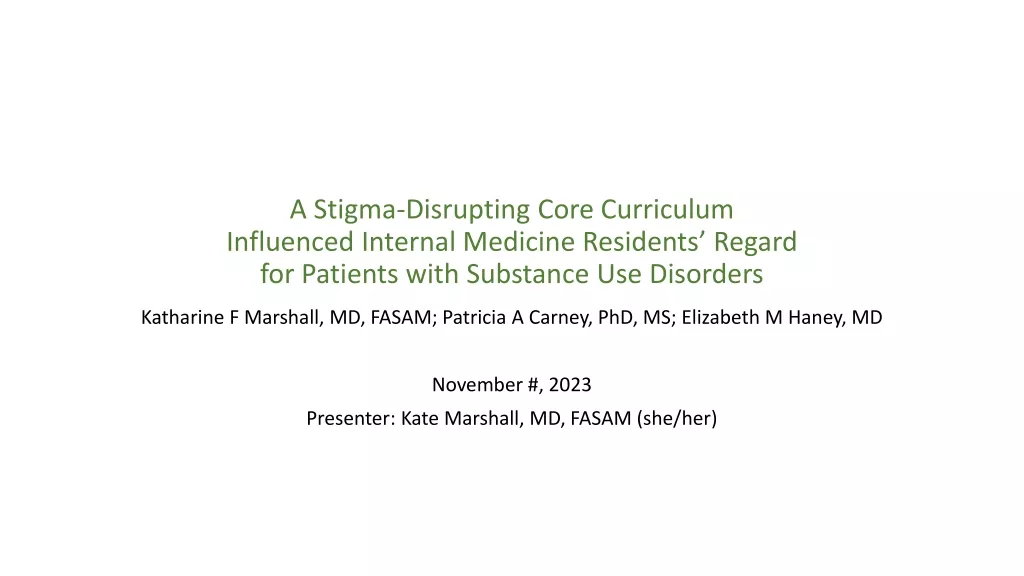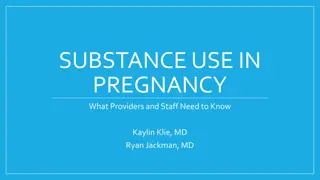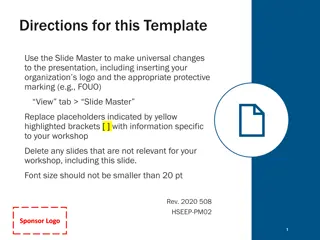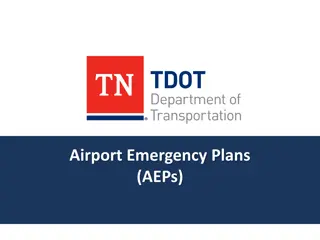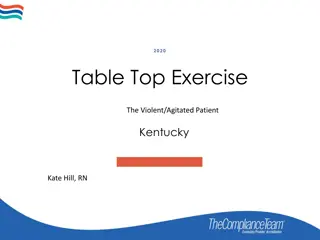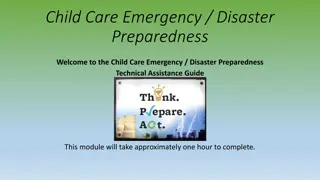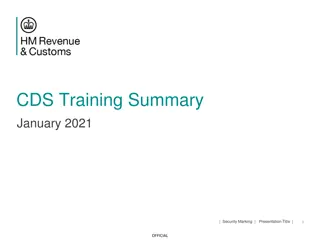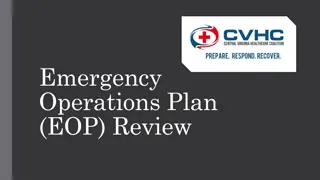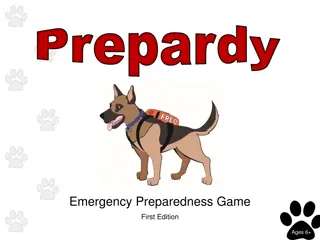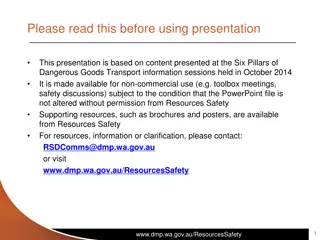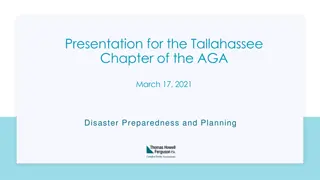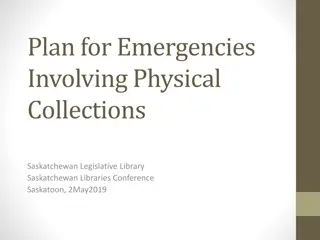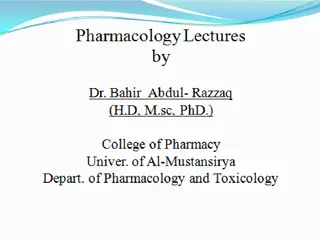Maryland's Controlled Dangerous Substance (CDS) Emergency Preparedness Plan
In 2011, a crisis unfolded in Wicomico County, Maryland, prompting the state to take action against a physician's questionable prescribing practices leading to an emergency suspension. The aftermath left up to 2000 patients without access to medications, facing community stigma and difficulties finding new providers. The impact rippled through the healthcare system and community, leading to increased challenges and tragic outcomes.
Download Presentation

Please find below an Image/Link to download the presentation.
The content on the website is provided AS IS for your information and personal use only. It may not be sold, licensed, or shared on other websites without obtaining consent from the author.If you encounter any issues during the download, it is possible that the publisher has removed the file from their server.
You are allowed to download the files provided on this website for personal or commercial use, subject to the condition that they are used lawfully. All files are the property of their respective owners.
The content on the website is provided AS IS for your information and personal use only. It may not be sold, licensed, or shared on other websites without obtaining consent from the author.
E N D
Presentation Transcript
Marylands Controlled Dangerous Substance (CDS) Emergency Preparedness Plan Michael Baier Overdose Prevention Director Maryland Department of Health and Mental Hygiene Behavioral Health Administration
Background 2011: Wicomico County, Maryland s Eastern Shore Mostly rural, medically-underserved region Large pain management practice run by anesthesiologist, interventional & Rx Legitimacy of physician s CDS prescribing practices questioned for years by local officials & providers Law enforcement investigations underway
The Trigger Medicaid MCO review finds standard of care violations related to CDS Rx in all 14 cases MCO refers records to state health dept. (DHMH) DHMH Chief Medical Officer reviews records & reaches same findings First time ever: DHMH Secretary summarily suspends physician s state CDS permit based on assessment of imminent public health threat from continued practice
The Aftermath Est. up to 2000 patients, many receiving CDS Rx (primarily opioids) Office closes & provides no medical record access Patients face stigma in community and can t find new providers for months or years Local health dept., hospital ED & community providers overwhelmed Local police link string of pharmacy robberies to former patients Pharmacies stop stocking opioids; primary care opioid Rx is chilled At least one patient suicide
Who are the Patients? No PDMP or other comprehensive data source easily available to DHMH existed in 2011. MCO auditor: His patient population reviewed was a combination of addicts, doctor shoppers and patients where opiates were unwarranted. Local police & health authorities: mostly addicted patients, many young, some likely diverting, also smaller number of older pain patients referred to phys. for legitimate reasons
Who are the Patients? Ctd. From a Health Care Alternative Dispute Resolution Office claim: I had two herniated and three bulging/slipped discs in my lumbar spine, as well as bi-lateral carpel tunnel syndrome and bi-lateral sciatica. Since I was referred to Dr. X, he increased my dosage of oxycodone (originally prescribed by my primary care physician) from 5 mg twice per day to 15 mg 3 times per day. When I asked Dr. X what the effects of taking such a strong dose would have on me, he informed me not to worry, that only 1 in 1000 patients prescribed narcotic pain relievers ever actually become addicted I had become addicted to narcotic pain relievers due to Dr. X s malpractice all other doctors refused to treat and care for me I had lost two good jobs, spent thousands of dollars, leaving my family impoverished, and I left attending Narcotics Anonymous and Worcester County Addictions Center Intensive Outpatient Group sessions three days a week for three hours a day.
Who are the Patients? Ctd. Local news op-ed: I have four bone spurs in my neck, fibromyalgia, RSD, two bone-to-bone knees, four bulging herniated discs in my lower back, and sciatica that goes down my right leg to my foot. I'm in so much pain, I have to see a psychiatrist and go to therapy. He gave me his full attention. Unlike other pain management doctors I've seen, he spends a lot of time with each patient. Other pain management doctors could take lessons from him. Neither of the doctors I was forced to go to cared about me, my pain and suffering or spent any time with me. Comments on online article about incident: It is criminal what these agency's have done to Dr. X s patients. Consider his case load of over 2000 patients. Maybe some of those were drug-seeking addicts, but surely not most. What happens to these people who are in severe, chronic pain? We are not able to get our medical records because nobody answers the phone, or comes to the door. You have to have your records before another doctor will see you, and even then, the earliest appointment I could find is mid-July. Patients were not told of the doctor's suspension, so many discovered it only when the tried to fill a dated prescription. No meds, no medical records, no alternate doctor. Lots of pain. Lots. Thanks, Priority Partners, DHMH, and Maryland Board of Physicians. In stopping a Doctor from prescribing for a few bad patients, you have effectively kicked the rest of us to the curb with no help at all. I thought your jobs were to HELP citizens get access to healthcare???
Who Owns this Problem? State Medical Board: Can order phys. to turn over records & assist patients but what happens if no compliance? Slow to act and highly bureaucratic State Health Dept: No existing infrastructure or resources to support patients despite use of CDS regulatory authority Insurance Carriers: Many Medicaid patients, few accepting providers in medically underserved area Local Health Dept: Tried to coordinate with local providers but very limited resources; limited space in SUD Tx programs, including single regional OTP Hospitals: No chronic condition mgmt. from ED Community Providers: Worried about taking on complicated, potentially disruptive patients and being next target of regulatory/enforcement action
Lessons Learned #1 Problem practices can grow over years in plain sight of locals, but regulatory/enforcement action is slow to identify and address. Need for state-level process to identify and intervene with potential problems before crisis develops. #2 Need for plan with resources to be deployed when abrupt, large scale cessation of CDS prescribing occurs in an underserved community
#1: CDS Integration Unit DHMH fusion center for info on investigations related to CDS Rx & dispensing Includes licensing boards, Medicaid, PDMP, CDS registration authority, medical examiner, inspector general, behavioral health, AG s office, etc. Member agencies identify CDS-related data sources, red flags and pool information for analysis May make recommendations to Secretary for further investigation, complaint with licensing board, action against CDS permit, etc. Possibility of intermediate sanctions tied to CDS permit, including education, mentoring, monitoring, etc.
#2: CDS Emergency Preparedness Plan GOAL IS: temporarily deploy resources at local level to mitigate impact on public health/safety and healthcare system. GOAL IS NOT: replace normal care coordination or patient referral processes or remove responsibility of practitioner, insurers, local health dept., etc. 2013 MOU b/t DHMH Behavioral Health Admin & Univ. of Maryland, School of Pharmacy (UMSOP) to develop plan UMSOP team: clinical pharmacists & RN w/ expertise in pain mgmt. & palliative care
Year 1: Plan Development Survey other states on model programs Conduct practitioner focus groups to aid plan development Assemble network of practitioners educated on process and figure our how to create rapid response team to assess patients, provide appropriate short term Tx/Rx and smooth referrals to community providers Develop educational/clinical support tools for RRT and other providers for use during event Identify responsibilities of players, including UMSOP, DHMH, LHDs, etc. Plan for disseminating info to local stakeholders and coordinating players
Survey of Medical and Pharmacy Boards High response rates Many reported experiencing abrupt cessation of prescribing due to disciplinary action Few report any formal or informal plan for response Little evidence of plans that include dedicated resources to assist patients during event
Focus Groups 3 separate groups for pain management & behavioral health experts, primary care providers and pharmacists Goals: Identify implementation barriers Develop clinical criteria for patient triage Identify documentation necessary to support patient referrals Develop cost estimate for purchasing practitioner time Provide ongoing feedback on plan development & implementation
Notable Focus Group Guidance Timely access to medical records is essential: Need for patient & pharmacy record-keeping to facilitate referral (med list, H&P, labs, imaging, consults, etc.) PDMP and health info exchange access Investigate legal authorities to compel disclosure UMSOP team should assist patients with compiling all available records during event Compile current lists of relevant providers by specialty area (pain, BH, primary care, etc.) Could regulators create a prescriber safe harbor in catchment area to reduce fear?
Clinical Support Tools (Still Under Development) Criteria for initial triage screening: low risk (referral to PCP), unknown risk, high risk (likely SUD & other comorbidities, referral to LHD behavioral health division) Take into account medical condition, CDS types/combos, SA/LA opioids, therapy duration, dosage frequency & escalation, adult/pediatric, has PCP?
Year 1: Obstacles 1. Complications of planning for abrupt cessation of ANY high volume CDS Rx (incl. benzos, bupe), not just OA for pain mgmt. 2. Inability to identify means to establish RRT: Practitioners need liability protection; only state employees/contractors covered by tort claims act State can t quickly bring on practitioners as employees/contractors UM system depts. unwilling to have practitioners provide Tx services; outside of employment scope Contract with temp services investigated but not practical 3. NEAR CONSTANT NEED TO RESPOND TO LICENSE SUSPENSIONS
Ad Hoc Responses to Date Temp suspension of another E. Shore pain mgmt. physician; agreed to work w/ UMSOP on triage West. MD bupe prescriber dropping patients in anticipation of Board sanction Temp suspension of radiologist who began pill mill Rx before retirement Temp suspension of So. MD internist/pediatrician, high volume benzo/stimulant Rx License surrender of elderly med. dir. of outpatient MH clinic with large benzo/bupe patient caseload
Key Components of Plan in Action
Initial Steps Licensing board notification (via CDSIU) of BHA of imminent sanction (weeks notice possible) BHA gathers intel & notifies UMSOP team & LHDs where patients reside (can t ID practitioner until order is public) In consult w/ licensing board, BHA attempts to contact practitioner (or attorney) to explain project and solicit cooperation
Alerting Local Providers UMSOP customizes template notifications for local providers about situation with patient instructions, work w/ LHD to distribute to: Local hospitals/ED Urgent care centers Pharmacies Other community practices Local law enforcement & EMS
If Practitioner Cooperates UMSOP project coordinator works w/ office staff to ID high priority patients & document clinical info UMSOP works with network providers & LHD to identify appropriate referral pathways and conduct follow-up Notifications instruct patients to call practitioners office, who works w/ UMSOP project coordinator.
If Practitioner DOES NOT Cooperate Notifications instruct patients to call LHD main line or special hotline, LHD POC works w/ UMSOP project coordinator. Harder to know whether high-risk patients are being identified and directed appropriately Requires constant monitoring/contact with community providers, hospitals, pharmacies, etc. to detect at-risk patients
Special Considerations Bridge providers don t want to est. long-term patient/provider relationship; what about patient abandonment? Bupe patients covered by 42 CFR Part 2; practice needs consent before disclosure of records => refer patients to LHD BH division for SUD assessment, possibly OTP Serious dangers from benzo withdraw => refer to local Core Service Agency; what is hospital role? How can PDMP, HIE be used more effectively to support rapid response?
Next Steps: Year 2-3 Finalize Plan, including P&P manual, clinical support tools, notification templates, stakeholder roles, etc. Continue building network of trained/educated providers willing to support rapid response Develop & implement plan for provider education (academic detailing?) on Plan & overdose prevention topics, including: Use of PDMP & HIE SBIRT Buprenorphine Naloxone Safe/effective CDS Rx education
Project Personnel Univ. of Maryland, School of Pharmacy Co-PIs: Kathryn Walker, PharmD, BCPS, CPE Mary Lynn McPherson, PharmD, BCPS, CPE Project Coordinator: Micke Brown, RN DHMH Behavioral Health Administration Kathleen Rebbert-Franklin, LCSW-C, Dep. Dir. of Population-Based Behavioral Health Michael Baier, Overdose Prevention Director Brian Holler, MPH, MOU monitor
Questions? Michael Baier Overdose Prevention Director Maryland Department of Health and Mental Hygiene Behavioral Health Administration michael.baier@maryland.gov 410-402-8643
